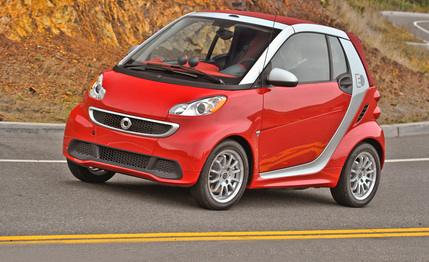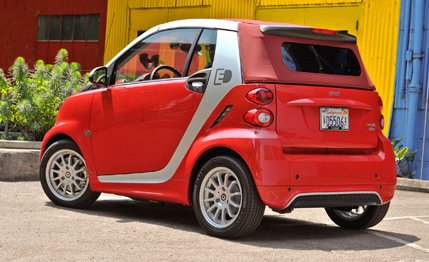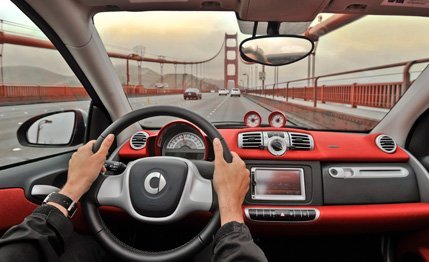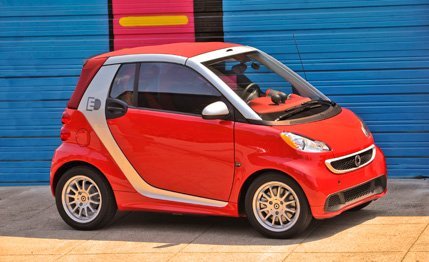
 First Drive Review
First Drive Review
It’s official: There’s no reason to buy the Smart Fortwo. Well, there’s no reason to buy the gasoline version now that the third-generation Smart Fortwo Electric Drive has arrived. This third attempt at electrifying the Smart is perhaps the one that will finally take. It now has a more powerful electric motor, slightly more range, and a price that can potentially undercut that of a Nissan Versa should you qualify for all the government incentives.
Priced from $20,740 if you opt in to Smart’s $80-per-month battery coverage, and sold solely in California and the 10 so-called ZEV states (Maine, Vermont, Connecticut, Oregon, Washington, New York, New Jersey, New Mexico, Rhode Island, and Massachusetts), the Smart electric comes well equipped. You will pay extra for navigation ($1290), metallic paint ($250), and accessories such as a cargo cover ($99), but the base electric is in line with the top-of-the-line Passion Plus gasoline model. Here’s how you get below 10 grand for your purchase price: Find a dealer who will kick in the full $2000 marketing assistance (dealer incentive), then factor in the $7500 federal tax credit and an additional $2500 if you live in California, and you can drive off in a new electric Smart for less than $9000.


Sense in the City
That $20,740 number does include the $5010 that Smart gives buyers for opting into the company’s Battery Assurance Plus coverage. Basically, you rent the battery for $80 a month for as long as you own the car. Smart warrants the battery against defects or loss in charging capacity and will service or replace the battery as necessary. Should you choose to lease the electric Smart, the price (with a $2000 capital cost reduction) for the base model is $139 per month for 36 months with $1999 down, and that payment includes the battery coverage.
Even if it cost the same as the gas version, the Smart electric would be the one to buy. Acceleration is brisk from a stop, thanks to the new, 74-hp electric motor that lives under the cargo area and weighs 33 pounds. All 96 lb-ft of torque are available as soon as you hit the accelerator, which gives the Smart the ability to squirt in and out of tiny spaces in traffic. Getting all 74 horses to come out and play does require the driver to push the accelerator past the kickdown switch. You’ll know that your Smart is giving 100 percent by watching the analog power gauge on the dash.


Power Ranger
Smart claims a believable 0-to-60 time of 11.5 seconds, and the top speed is now a freeway-friendly 78 mph—the previous Smart electric stopped accelerating at 63 mph and hit 60 mph in 23.4 seconds. The 74 horsepower is limited, though. Should you pin the “gas pedal” for two minutes straight, the electric motor’s power diminishes to 47 horsepower. During our two-hour drive of the Smart in San Francisco, we did not encounter any loss of performance.
Buyers will likely be more concerned with the Smart’s range. A new lithium-ion battery pack is mounted under the floor and provides 17.6 kWh of power and an EPA range of 76 miles in the city cycle. The Smart is good for 107 MPGe in the combined EPA cycle. Charging a completely discharged battery takes six hours with a 240-volt, 20-amp connection. Those times grow to 14 hours if you plug into a regular 110-volt outlet.
Range and charging times are the only advantages the gas-fed Smart enjoys versus the electric, but we can’t imagine that many Smart owners regularly drive their cars long distances. The electric Smart feels quicker than the gas version, it’s much quieter, and best of all, it doesn’t snap your neck when it finally clumsily changes gears. That’s because the electric Smart’s drivetrain never changes gears; as a result, power delivery is perfectly smooth. The Smart EV feels more sure-footed and solid than the gas version. Batteries add about 400 pounds to the curb weight for a total of about 2150 pounds. The added battery weight sits low in the car, eliminating the tippiness and instability of the gas version; handling is now secure.


As with other electric cars, the Smart has regenerative braking that spins the electric motor to recharge the battery. Let off the accelerator, and the Smart decelerates quickly. In traffic, the electric Smart can be driven without having to hit the brakes very often. When you do apply the brake pedal, there’s a disconcerting grabby response from the mechanical brakes as they transition from regenerative braking.
In its most basic guise, the Smart electric makes more sense than other Smarts. Even the $3000 premium for the convertible seems reasonable when you consider there is no other electric convertible available. The Smart remains a tiny, two-seat car that is best left in an urban center, but electrifying it has made it better to drive. Lowering the price has made it palatable. Now Smart just has to take the styling in a new direction, preferably one that is 180 degrees opposite of the ridiculous swan-boat-inspired Fortwo Edition by Jeremy Scott.